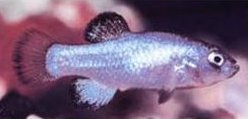drhoz
in
wtf_nature
Devil's Hole Pupfish
This was pointed out to me by ozraptor4, and really should have immediately followed the Mummichog post, but I was pipped at the post by the psychic octopus.
Whereas Fundulus heteroclitus heteroclitus is one of the most habitat tolerant fish around (apart from that odd blindspot about aquaria ), another Cyprinodontiforme is almost the exact opposite - the entire wild population depends on a single limestone shelf just 2x4 metres across for all its spawning and most of their food.

Cyprinodon diabolis is native to Devil's Hole, a geothermal pool in a limestone cavern, in the Amargosa Pupfish Station of the Desert National Wildlife Refuge Complex east of Death Valley. The water temperature is 34 degrees Celsius ( 93°F ), food sources are extremely limited, and sunlight only hits the surface of the spawning shelf four months out of the year. And the pupfish here, and other species at sites nearly as horrendous, have clung on for the thousands of years since the last Ice Age.
The natural population at Devils Hole fluctuates depending on the season - only 150 to 250 in Spring, because of low light and cold in winter, and up to four or five hundred by Autumn. BUT - earthquakes, flashfloods, and agriculture removing groundwater can all cause the population to crash. In 2004 a flashflood killed a third of the population by washing scientific equipment and other debris into the cave.Some Devil's Hole Pupfish have been moved to artificial refuges that try to mimic the environment of Devils Hole, with limited success. One population lives in a concrete tank at Hoover Dam. Another was taken to a Las Vegas casino.
But even though the current population - at last count 124 - is so small that the ongoing genetic viability of the species is severely compromised, and they're being given extra food to try and build up the numbers, the biggest threat remains water-level fluctuation. Formal protection began in 1952 when the cave was made part of Death Valley National Monument, followed by Endangered Species designation occurred in '67, followed by the formation of the Desert Fishes Council to fight agricultural interests for the species' protection. The case went all the way to the Supreme Court. Happily, the fish won.
Whereas Fundulus heteroclitus heteroclitus is one of the most habitat tolerant fish around (apart from that odd blindspot about aquaria ), another Cyprinodontiforme is almost the exact opposite - the entire wild population depends on a single limestone shelf just 2x4 metres across for all its spawning and most of their food.

Cyprinodon diabolis is native to Devil's Hole, a geothermal pool in a limestone cavern, in the Amargosa Pupfish Station of the Desert National Wildlife Refuge Complex east of Death Valley. The water temperature is 34 degrees Celsius ( 93°F ), food sources are extremely limited, and sunlight only hits the surface of the spawning shelf four months out of the year. And the pupfish here, and other species at sites nearly as horrendous, have clung on for the thousands of years since the last Ice Age.
The natural population at Devils Hole fluctuates depending on the season - only 150 to 250 in Spring, because of low light and cold in winter, and up to four or five hundred by Autumn. BUT - earthquakes, flashfloods, and agriculture removing groundwater can all cause the population to crash. In 2004 a flashflood killed a third of the population by washing scientific equipment and other debris into the cave.Some Devil's Hole Pupfish have been moved to artificial refuges that try to mimic the environment of Devils Hole, with limited success. One population lives in a concrete tank at Hoover Dam. Another was taken to a Las Vegas casino.
But even though the current population - at last count 124 - is so small that the ongoing genetic viability of the species is severely compromised, and they're being given extra food to try and build up the numbers, the biggest threat remains water-level fluctuation. Formal protection began in 1952 when the cave was made part of Death Valley National Monument, followed by Endangered Species designation occurred in '67, followed by the formation of the Desert Fishes Council to fight agricultural interests for the species' protection. The case went all the way to the Supreme Court. Happily, the fish won.